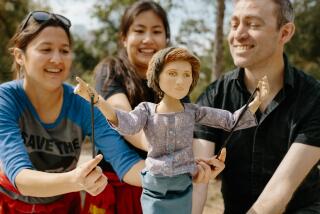KCET Plans New Preschooler Series : Television: ‘The Puzzle Factory,’ scheduled to premiere in the fall of 1993, will reach out to children in day-care centers.
- Share via
KCET Channel 28 will receive $4.5 million in federal funding to produce public television’s first new series for preschoolers since “Sesame Street,” officials at the Corporation for Public Broadcasting said Monday.
The new show, whose working title is “The Puzzle Factory,” is slated to premiere in the fall of 1993 and will feature a multicultural band of human-like puppets who work out “life’s little problems” in the puzzle factory where they labor.
KCET, which will produce the series with New York-based Lancit Media, which produces PBS’ “Reading Rainbow,” must raise another $5.5 million in private grants to fund the proposed 65 half-hour episodes and an ambitious support program designed to reach children where many of them will be watching the show--in day-care centers.
The chief puppeteer will be Kevin Clash, who operated the character Splinter in the two “Teenage Mutant Ninja Turtles” films, and who has worked with Jim Henson Productions as the Muppet characters of Elmo, Hoots and Natasha on “Sesame Street.”
Phylis Geller, senior vice president of national productions at KCET, said that “The Puzzle Factory” will differ from PBS’ preschool cultural institution by being “more sociological than ‘Sesame Street,’ dealing more with behavior.”
“It’s about choices and getting along with others,” Geller said. “(It’s about) understanding that all people have value even if they’re different from you.”
Each day, she said, the puppets in the factory will have to make a new puzzle. Along the way, they will encounter and solve problems of social interaction. The series will also include documentary segments and musical interludes, all of which lead up to solving the day’s obstacles.
Unlike “Sesame Street,” the puppets will be designed to look like people, Geller said, so that young viewers will understand that the problems faced by the puppets might also be faced by themselves.
“The Puppet Factory” will be the first program for preschoolers that, from its inception, was made with the awareness that millions of the show’s potential audience members are in professional day care, Geller said.
For that reason, a good portion of the series’ $10-million budget will be devoted to an “outreach” plan that includes special activities for day-care providers and preschool teachers to use with children who watch the show, she said.
“It will include a mailbag full of stuff, including ways for kids to tell their own stories” based on issues raised in the series, Geller said.
“The Puppet Factory” is one of the first programs funded under a new policy at the Corporation for Public Broadcasting--the nonprofit agency charged with distributing the money that Congress allocates for public broadcasting--designed to better focus its funding efforts.
In the past, the corporation accepted proposals of any sort from producers who had ideas about programming, and then decided whether to fund them. But now the agency is putting out specific requests for programs that its executives and PBS programming chief Jennifer Lawson have agreed to fund.
“We looked at the voids that need to be filled in children’s television, and we really wanted something that would help kids make life decisions and help them live in a multicultural setting,” said Donald Marbury, director of the corporation’s television fund.
Initially, he said, he argued that they should be targeting programs for older children, because “Sesame Street” and “Mr. Rogers’ Neighborhood” were already serving preschoolers.
“I wanted to push us in the teen-age direction,” Marbury said. “I had research that said we could do great good with the teen-agers.”
But he said that PBS’ Lawson favored a program for preschoolers, and subsequent research supported a need for such programming.
And he said that PBS’ heavy emphasis on preschool programming would soon be offset by series currently in development, such as “Ghostwriter,” about a group of children who solve mysteries with the aid of a ghost; “Hoop Dreams,” about Chicago teens who dream of glory as basketball players; and “Conan the Librarian,” a series that encourages reading.
“Does the fact that there is more than one sitcom on commercial television mean that there can’t be (a new) one?” said PBS spokeswoman Mary Jane McKinven. “Just because there is one doesn’t mean you can’t have another.”
Peggy Charren, head of the consumer group Action for Children’s Television, said that she thinks the most under-served group of children are those aged 7 to 12. That group is inundated with cartoons and other shows on the commercial networks, but have little to watch that is on par with the PBS preschool programs like “Sesame Street.”
Still, Charren said, she is supportive of plans to fund “The Puzzle Factory.”
PBS and the Corporation for Public Broadcasting, she said, are hoping to shore up public television’s hold on preschoolers with “The Puzzle Factory,” and then follow up with programs for the same children as they grow older.
More to Read
The complete guide to home viewing
Get Screen Gab for everything about the TV shows and streaming movies everyone’s talking about.
You may occasionally receive promotional content from the Los Angeles Times.






